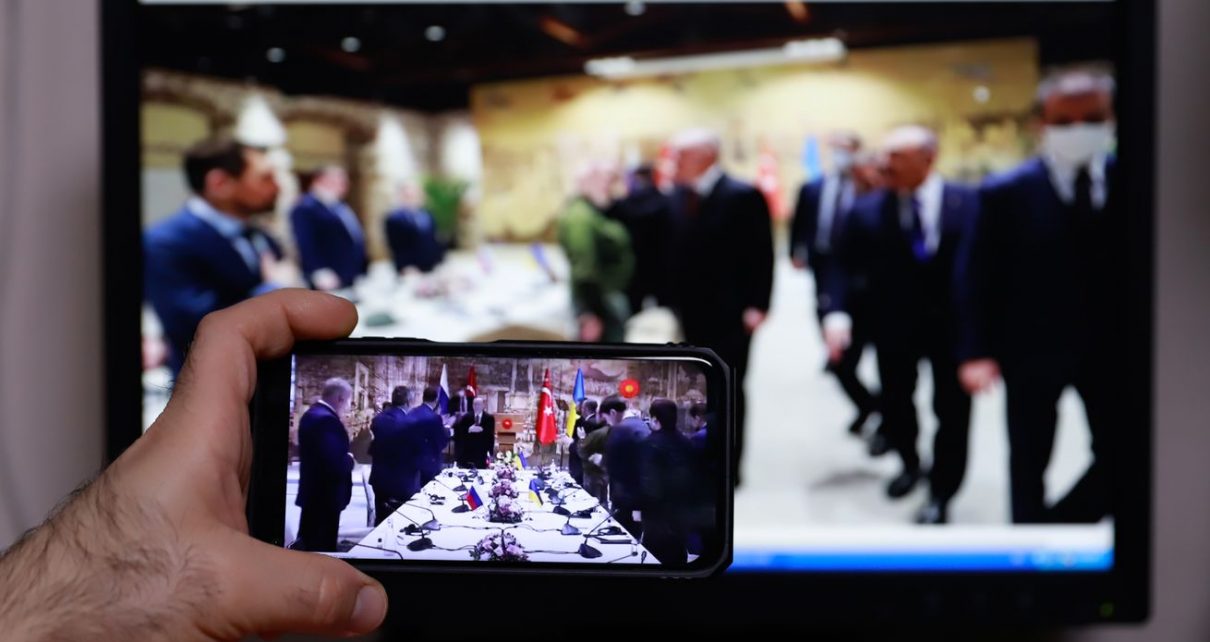
Russia and Ukraine are talking, but huge gulfs remain.
The war in Ukraine has ground on for five weeks. For almost as long, Russian and Ukrainian officials have been attempting to negotiate.
Those negotiations have yielded few firm results so far, especially as Russia continues to bombard Ukrainian cities. Still, the talking matters. Diplomacy is the only way this war will finally end, and the type of agreement that might end the fighting looks a lot clearer than it did even a month ago.
In the early days of the war, the talks made little apparent progress. Ukraine appeared to be demanding an immediate ceasefire, and Russian withdrawal of troops.
Russia, however, had pretty different ideas. It laid out some aggressive demands. Among them were: Ukraine’s neutrality and no membership in the North Atlantic Treaty Organization (NATO); so-called “demilitarization and “denazification;” the protection of Russian language within Ukraine; and that Ukraine recognize Crimea as part of Russia and recognize the independence of Donetsk and Luhansk, the two regions in eastern Ukraine that Vladimir Putin had declared as independent on the eve of his full-scale invasion.
In recent days, some glimmers of optimism have emerged. Ukraine has put forward serious proposals, which is centered around a commitment to permanent neutrality and an agreement not to seek NATO membership, in exchange for security guarantees. Russia has also reportedly eased up on some of its previous demands, including “denazification” — a likely ruse for regime change — and “demilitarization,” a sign that Ukraine’s battlefield successes so far have pushed the Kremlin to possibly reconsider some of its most maximalist demands.
Mevlut Cavusoglu, Turkey’s foreign minister, who is helping to broker the talks, described the discussions earlier in the week as “the most meaningful progress since the start of negotiations.”
But these really are just glimmers of progress — and they might not be so long lasting. Russia, this week, promised to “drastically reduce” military activity around Kyiv and Chernihiv, in the name of “mutual trust,” though reports of shelling continued in those areas. Some, including US and NATO officials, have expressed skepticism that Moscow is sincere, and instead using talks to buy time, so it can regroup and refocus its offensive, potentially on areas in eastern and southern Ukraine. Since then, both Russia and Ukraine have downplayed the seriousness of the talks, even as negotiations resumed Friday.
And huge gulfs remain. Perhaps the most intractable problem may be the future of the Crimean peninsula, which Russia annexed in 2014, and Donetsk and Luhansk, which Russia and Russia-backed militias control parts of. Ukraine is unlikely to agree to slice up its country. It is also hard to imagine Russia settling for less territory than it controlled the day before its invasion in February 2022.
Other issues will emerge, and concessions and proposals may shift depending on developments in the battlefield.
The prospect of a quick peace deal between Ukraine and Russia remains unlikely. Perhaps the best case short term is that both sides broker a ceasefire that includes a framework for an agreement, and then work the details out over time. But the war continues.
Ukrainian neutrality is likely to be the central component of any peace deal
A neutral Ukraine is likely to be central to any peace deal. In broad terms, that would likely mean Ukraine would have to agree to remain a nonnuclear power, abandon its ambitions of ever joining NATO and forego any NATO installations or troops on its territory, in exchange for some sort of security guarantees. Ukraine has indicated that it would put this issue to a referendum, which would propose changing the constitution to remove any NATO aspirations and accepting a status of permanent neutrality.
Both Ukraine and Russia may find something palatable in the idea. Ukrainian President Volodymyr Zelenskyy has previously acknowledged that Ukraine will not actually join NATO, but for now Ukraine remains committed to having the right to pursue European Union membership. Russia has what it sees as legitimate security concerns about NATO being on its borders, so a militarily neutral Ukraine may also be something Russia could accept, if keeping NATO out of Ukraine, and away from Russia’s borders, is an outcome Putin could spin at home. Kremlin spokesperson Dmitry Peskov has said previously that a deal for a neutral Ukraine could be a “kind of compromise.”
Ukrainian neutrality, said Pascal Lottaz, assistant professor for neutrality studies at the Waseda Institute for Advanced Study, may be the only option “where all the parties — the Russians, the Ukrainians, and the US and NATO — would basically sit down and say, ‘Fine, we can accept that; fine, we can live with that.’”
But it will depend on the details. Ukraine committed to neutrality in the aftermath of the breakup of the Soviet Union; each of its swings away from neutrality was usually in response to Russian threats or aggression. Ukraine formally abandoned its neutral status in 2014, after Russia annexed Crimea and invaded Eastern Ukraine.
Putin has also gone far beyond NATO grievances, essentially denying Ukrainian statehood. At the outset of the war, he demanded the “demilitarization and denazification of Ukraine,” a false attack that is largely code for regime change. In other words, Putin’s maximalist position doesn’t really square with just accepting neutrality.
Battlefield losses and Ukraine’s resistance may have changed Moscow’s calculus. But that doesn’t change the bigger issue: Who trusts Putin now?
“There were probably at least a dozen international agreements that Russia signed with Ukraine that did commit Russia to respecting Ukraine’s December 1991 borders, yet, the Russian government has shown no importance to adhering to those obligations,” said Mark Kramer, director of the Cold War Studies Project at Harvard University’s Davis Center for Russian and Eurasian Studies.
If Ukraine agrees to a neutral status, it is likely to want some guarantees that it will stay that way. That is where the rest of the world comes in, likely the US and its allies. Ukraine has reportedly proposed Russia, Great Britain, China, the United States, France, Turkey, Germany, Canada, Italy, Poland, and Israel, as possible guarantors. A lot depends on what risks these guarantors are willing to tolerate — and whether that would be acceptable to Ukraine or Russia.
How strong these guarantees are matters. If they involve NATO allies committing to defending Ukraine in case Russia launches another full-scale invasion, that would be a lot like NATO’s Article 5 mutual self-defense pact in all but name. “Would the United States or other NATO countries be allowed to use military force if an agreement in the family is violated? That, I think, may be a bridge too far for the Russians at this point,” said P. Terrence Hopmann, a professor of international relations at Johns Hopkins University.
But, Hopmann added, given the bad faith Putin has shown in negotiations, it will be difficult for Ukraine to accept neutrality without some serious security guarantees. Other experts said non-military mechanisms, like automatic sanctions or other penalties, are an option. Adding to the uncertainty: For Ukraine, it’s still risky to put its fate in the promises of outside powers, especially those like the United States, who, under some presidents, have shown their own willingness to break international agreements.
The big issues are going to be Crimea and the Donbas
In 2014, Russia annexed the Crimean peninsula, and Russian troops invaded in support of separatists in the Donbas in eastern Ukraine. Russia has supported those separatists in an eight-year war with Ukrainian forces ever since.
Russia has insisted that Ukraine recognize Crimea as part of Russia. Ahead of Russia’s invasion in February, President Vladimir Putin declared two regions, Donetsk and Luhansk, as independent, and the Kremlin now wants Ukraine to do the same. However, they are asking those “republics” encompass the entire oblasts (basically, administrative regions), which is way more territory than Russia, or Russian-backed militias, currently control.
At least right now, this is an untenable demand for the Ukrainian government.
“No Ukrainian government, I think, would ever be able to do that and survive. And this government shows no indication of being willing to do so. And frankly, Russia hasn’t even won the territorial control piece on the battlefield yet,” Samuel Charap, a senior political scientist at RAND said Tuesday during a discussion hosted by the Quincy Institute for Responsible Statecraft. Ukraine’s foreign affairs minister Dmytro Kuleba has said that Ukraine will not trade “people, land or sovereignty.”
The Ukrainian government, however, countered with some proposals on how to handle these regions. On Crimea, it has proposed that its status be worked out over the next 15 years, with Ukraine vowing not to retake the peninsula by force in the meantime. On the Donbas regions, Ukraine has proposed that Zelenskyy and Putin work out the status in direct talks.
Those aren’t solutions, but Ukraine’s proposals at least suggest a willingness to negotiate. For Ukraine, there are potential political paths to address these territories’ status, including implementing referendums with international backing and observers, to ensure their legitimacy.
Russia, however, may be trying to force the issue on the battlefield, as it has indicated that it will now focus on operations in eastern Ukraine. This may, in part, be a recognition that its efforts to take Kyiv have failed, but it may also be an attempt to try to take more and more territory in this region to try to carve out a slice of Ukraine that extends from the Crimean peninsula up to territories in the east. Whether Russia will be successful — and what kind of devastation it might unleash to attempt to do that — is still unclear. And even if Russia seizes these areas, the citizens left behind after a brutal offensive may not be willing to accept that.
Demilitarization, denazification, and everything else
At the outset of negotiations, Russia put forward some pretty wild demands, specifically the demilitarization and “denazification” of Russia.
Denazification seemed mostly code for regime change, as Putin has sold Russia’s war at home as a “special military operation” to save Russian-speakers, who he claimed were being persecuted. He described the Ukrainian regime as controlled by “drug-addled Nazis.” (Zelenskyy is Jewish and has family who died in the Holocaust.) Exactly what demilitarization means is also unclear, but experts said it could mean limits on Ukraine’s offensive weapons or troop numbers. But the idea that Ukraine would give up its military after being invaded seems unfathomable, and, most neutral countries maintain armies for at least territorial defense.
There are some signs that Russia may be easing off those requests. The Financial Times reported Monday that a draft ceasefire document did not address those issues, and Zelenskyy previously said he would not discuss those terms with Russia.
Russia has also objected to policies that it sees as deliberately targeting Russian language, and wanted protection for Russian language. Zelenskyy has said that Ukraine is willing to discuss questions of the Russian language.
The hope is that some of these more extreme and unspecific demands will fall away, or Russia and Ukraine can work out some superficial solutions — like condemning Nazis — that would suffice. That would leave the still-thorny questions of neutrality and territorial control as the key facets of any deal.
Here, perhaps, is where the United States, Europe, and other allies come in. The West has imposed unprecedented sanctions on Russia, and the pain is likely to deepen in time. The US has signaled that it is willing to support Ukraine in its negotiations, but sanctions relief may also be necessary leverage against Russia, the longer this war grinds on.
But any deal will be shaped, at least in part, by what happens on the battlefield. And Russia has not stopped waging war against Ukraine — but neither has it won.




